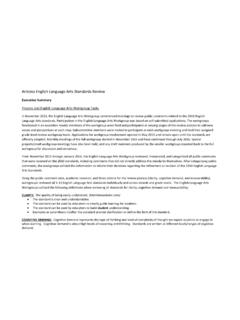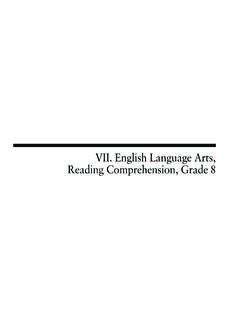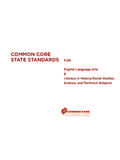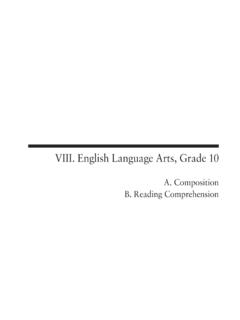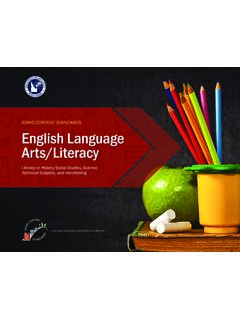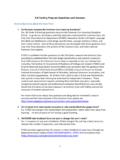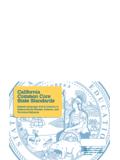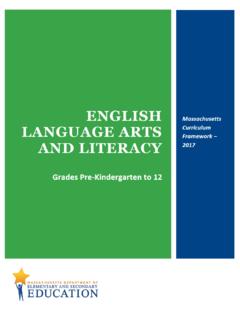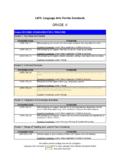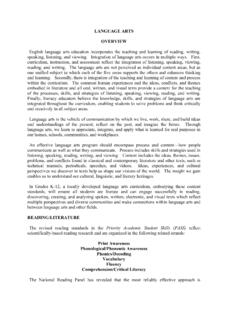Transcription of Arizona’s English Language Arts Final Draft
1 arizona s English Language arts Final Draft arizona DEPARTMENT OF EDUCATION HIGH ACADEMIC STANDARDS FOR STUDENTS December 2016 arizona s English Language arts Standards 2016 Introduction arizona DEPARTMENT OF EDUCATION HIGH ACADEMIC STANDARDS FOR STUDENTS Final Draft December 2016 1 The arizona English Language arts Standards: Introduction Purpose of the Standards The arizona English Language arts Standards define the knowledge, understanding, and skills that need to be effectively taught and learned for all students to be ready to succeed in credit-bearing, college-entry courses, in the workplace, and/or in military service. The standards present a vision of what it means to be a literate person in the twenty-first century.
2 Grade-specific K-12 standards in Reading, Writing, Speaking and Listening, and Language translate the broad aims of The arizona English Language arts Anchor Standards into age- and attainment-appropriate terms. These standards allow for an integrated approach to literacy to help guide instruction. Process for the Development of the Standards In response to the call from Superintendent Douglas and Governor Ducey to review and revise the arizona English Language arts Standards, an extended, broad-based effort was led by arizona educators to create the next generation of successful K-12 arizona students. The standards revision workgroups built the current standards using research and input from numerous models and sources, including parents, students, K-12 teachers, state departments of education, scholars, academic and instructional coaches, curriculum directors, administrators, university professors, and other members of the public.
3 The ELA Standards Review Work Group: Reviewed thousands of comments from two sessions of public feedback on the standards; Reviewed technical feedback from experts in English Language arts and Educational Psychology; Revised grade-level standards, applying grade-level expertise and research while addressing public and technical feedback; and Developed the Draft of the arizona English Language arts Standards for adoption by the arizona State Board of Education. The standards review process was made up of the following groups: ELA Standards Review Work Group (over 100 members) - fluid groups of diverse, arizona , K-20 content experts responsible for creating working drafts of the standards; ELA Standards Subcommittee (14 members) - permanent working group members for each grade level who approved standards revision decisions and represented the thoughts of the grade-level work groups in public meetings.
4 arizona Standards Development Committee (17 members) - a group appointed by the arizona State Board of Education and made up of parents, business representatives, community members, teachers, and university professors who approved decisions and drafts presented by the ELA Standards Subcommittee prior to presentations and Final adoption by the arizona State Board of Education; and arizona State Board of Education - the Final decision-making body for the standards. 2 What the arizona English Language arts Standards Are The arizona English Language arts Standards are the foundation to guide the construction and evaluation of English Language arts programs in arizona K-12 schools and the broader arizona community. The arizona English Language arts Standards are: Focused in a coherent progression across grades K-12, Aligned with college and workforce expectations, Inclusive of rigorous content and applications of knowledge through higher-level thinking, Research and evidence based, Broad in nature, allowing for the widest possible range of student learning, and Designed as an integrated approach to literacy.
5 What The arizona English Language arts Standards Are NOT The standards are neither curriculum nor instructional practices. While the arizona English Language arts Standards may be used as the basis for curriculum, they are not a curriculum. Therefore, identifying the sequence of instruction at each grade - what will be taught and for how long- requires concerted effort and attention at the local level. Curricular tools, including textbooks, are selected by the district/school and adopted through the local governing board. The arizona Department of Education defines standards, curriculum, and instruction as: Standards are what a student needs to know, understand, and be able to do by the end of each grade. They build across grade levels in a progression of increasing understanding and through a range of cognitive demand levels.
6 Standards are adopted at the state level by the arizona State Board of Education. Curriculum refers to resources used for teaching and learning the standards. Curricula are adopted at the local level. Instruction refers to the methods or methodologies used by teachers to teach their students. Instructional techniques are employed by individual teachers in response to the needs of the students in their classes to help them progress through the curriculum in order to master the standards. Decisions about instructional practice and techniques are made at a local level. The standards do not necessarily address students who are far below or far above the grade level. No set of grade-specific standards can fully reflect the great variety in abilities, needs, learning rates, and achievement levels of students in any given classroom.
7 The arizona English Language arts Standards do not define the intervention methods to support students who are well below or well above grade level 3 expectations. It is up to the teachers, schools, and/or districts to determine the most effective instructional methods and curricular resources to meet all students needs. Overview of the Standards Reading: Text complexity and the growth of comprehension The arizona Reading standards place equal emphasis on the sophistication of what students read and the skill with which they read. Anchor Standard 10 ( ) defines a grade-by-grade staircase of increasing text complexity that rises from beginning reading to the college, career, and military readiness level. Students must also show a steadily growing ability to discern more from, and make fuller use of text.
8 This includes making an increasing number of connections among multiple ideas and texts, considering a wider range of textual evidence, and becoming more sensitive to inconsistencies, ambiguities, and poor reasoning in texts. An expanded definition of text complexity can be found in the glossary. Reading: Foundational Skills (K-5) The arizona Reading Foundational Skills standards are directed toward fostering students understanding and working knowledge of concepts of print, the alphabetic principle, and other basic conventions of the English reading and writing system. These foundational skills are not an end in and of themselves; rather, they are necessary and important components of an effective, comprehensive reading program designed to develop proficient readers with the capacity to comprehend texts across a range of types and disciplines.
9 Instruction should be differentiated; good readers will need much less practice with these concepts than struggling readers will. The point is to teach students what they need to learn and not what they already know- to discern when particular children or activities warrant more or less attention. Writing: Text types, responding to reading, and research The arizona Writing standards acknowledge the fact that while some writing skills, such as the ability to plan, revise, edit, and publish, are applicable to many types of writing, other skills are more properly defined in terms of specific writing types: arguments, informative/explanatory texts, and narratives. Standard 9 stresses the importance of the writing-reading connection by requiring students to draw upon and write about evidence from literary and informational texts.
10 Because of the centrality of writing to most forms of inquiry, research standards are prominently included in this strand, though skills important to research are infused throughout all strands. Writing: Foundational Skills (K-3) The arizona Writing Foundational Skills standards provide guidance to support handwriting skills, sound-letter concepts, and spelling conventions and patterns. Through frequent experiences starting at a young age, students begin to discover why and how we write, to generate ideas about how written 4 Language works, and to explore its uses. Beginning with pictures and progressing through phonetic spelling to more conventional writing, students develop the core skills for written communication. By the end of fifth grade, students will demonstrate proficiency in cursive writing.
